
| Human Powered Clock Drive | |
| Articles | AstroGuide | Calendar | Classifieds | Constellations | Forums Meteors | Moon | News | Photography | Planets | Shop | Other Sites |
|

 |
|
 |
|||
|
|
|||||
| by Zac August 26, 2001 |
Think you need exotic materials and a machinist's know-how to get good astro photos? After you read this you won't. Described is a human powered clock drive built from readily available materials. |
Shown
is a human powered clock drive for astrophotography
that works very nicely, is easy to build and can yield great results.
| This... |
 |
| ...gets you this... |
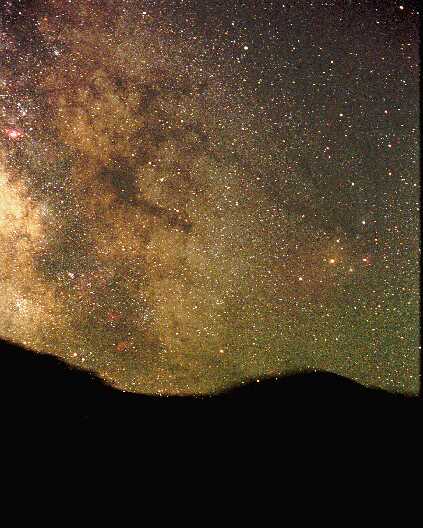 |
There are 86,400 seconds in a day and, if you, arbitrarily, want to rotate a knob once a minute like the second hand on a clock then you need a reducing gear ratio (or ratio of radii) of 1 to 1440. Since most hand guided astrophotos are going to be less than ten minutes in duration, you do not need to cut out a 2.88 meter diameter piece of wood and drive it with a 2mm diameter gear, for example. A 1.44 meter length of 1" by 3" lumber will do, for example. And you don't have to put a radius on it either.
Also, must a gear have teeth or threads? If you place a pencil under a large book and rotate the pencil in place, the book will ride over the rotating pencil. This is an example of a friction driven gear with a rather large gear ratio.
My clock
drive is essentially
two pieces wood of joined together
with a
single nail. One piece is the stationary "baseplate" and the other
piece (cut to
a specific length with respect to the nail) is the "hour hand" that
should move
just like the hour hand of a military style 24 hr clock. The "hour
hand", which
will naturally rest at the 6 o'clock(12hr clock military)position, is
driven at
the bottom of the hand by riding over a small diameter steel rod
mounted at a 45
degree angle on the baseplate.
From the star charts, it appears the celestial pole lies between Polaris and Kocab, the star at the end of the cup of the little dipper. So if you place Polaris on the rim of sight tube that is the furthest from Kocab, you should have a pretty good alignment with the celestial pole.
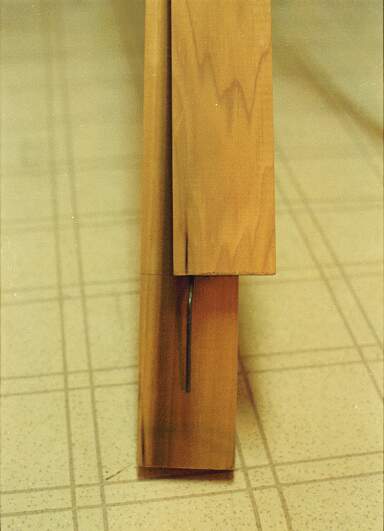
The "hour hand" gear is a 50" long piece of 1"x3" poplar lumber and extends 45" from the axis of rotation formed by the steel sight tube. The little gear is a piece of 1/8" diameter steel welding rod which has a radius of 1/16". Since I don't plan on taking exposures longer than 10 minutes, the big gear doesn't have to be a huge 90 inch diameter circular piece of wood. A simple 1"x3" plank will do just fine.
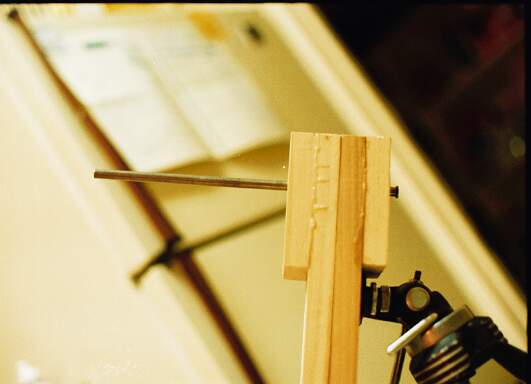
If you drill 5/16" hole, centered from side to side on the 1"x3", 45 inches from one end of the plank and shove a straight 5/16" o.d. piece of steel brake line that is 12.75 inches long, you now have an axis of rotation for the big gear that doubles as a 1.5 degree FOV bore sight for polar alignment. Mount this gear onto some kind of a baseplate by drilling a same size hole through the baseplate and shoving the brake line through both pieces of wood. For my baseplate I use a 60" length of 1"x3" poplar wood.

Find exactly where the bottom of the "hour hand" lies on the baseplate and drill a 1/8" diameter hole into the baseplate at a 45 degree angle, tilting away from the big gear.
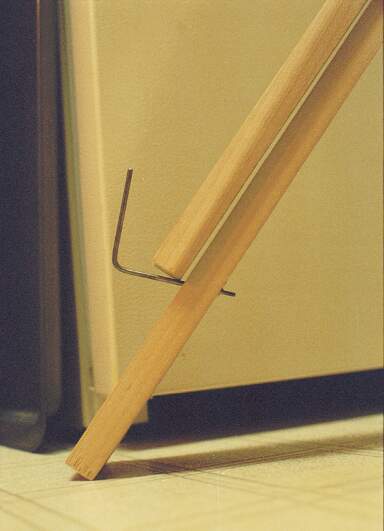
Shove in the 1/8" dia. steel welding rod and check it's position with respect to the big gear ( aka the "hour hand"). The rod should prevent the bottom of the hour hand from touching the baseplate. The clearance between the baseplate and the big gear should be less than 1/8" or so to prevent bending of the sight tube and pinching the wood against the sight tube. Barring acts of God, you should now be able to rotate the rod and the "hour hand" will ride over the rod just as smooth as a baby's bottom.

The baseplate is leaned against a camera tripod and attached to it's mounting plate. Thus, the baseplate forms a "fourth" leg of the tripod. This configuration is very stable in windy environments and will not jiggle when you turn the knob every fifteen seconds. Since I am at 37 degrees North latitude, I drilled a hole for the tripod mount 46.5" up from the bottom of my baseplate (the camera mount screw on my tripod is 36.5" above the ground) so that, when mounted to my camera tripod, it will point at roughly the correct altitude for Polaris.
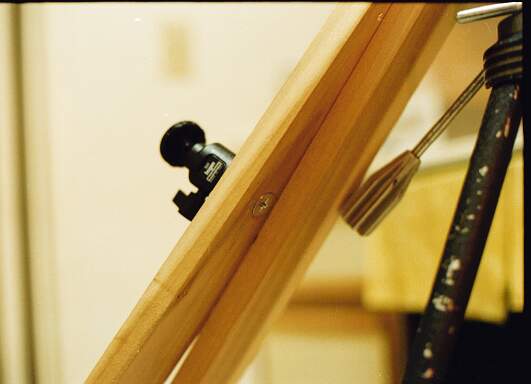
Purchase a "Bogen 3009 mini ball head" at photographic supplies store for $30. This is a beautiful, simple, no ball mount that gives you complete freedom of movement. Make sure you firmly attach it to the "hour hand" plank so that the weight of the camera will not slowly unscrew the ball mount while taking a picture. To assure free movement of the hour hand, you need a flush head screw to mount the ball head.
Attach your camera to the big gear's ball mount, attach star tracker to your tripod, aim the brake line at Polaris and rotate the rod COUNTER-CLOCKWISE 1/8 turn every fifteen seconds. My tracker gives me about 12 minutes of exposure time before the "hour hand" falls off the 1/8" diameter rod! Bending the 1/8" welding rod into an "L" shape makes for a convenient handle.
Enjoy!
Here are some of the first photos I've made with this device:
FirstLagoon.jpg
34K  This
is the first hand guided
astrophoto I've ever taken. It is a
four minute exposure taken in the summer of 1997 sort of near New
Idria,
California. It is an abandoned mining town halfway between Fresno and
the
Pacific ocean. I used an old Nikkormat mechanical camera with a Nikon
Nikor 50mm
f1.4 lens stopped down to f2.8. The film was Kodak 400 speed color
print film
purchased at Safeway. The negative was scanned in with an HP photosmart
photo
scanner. This
is the first hand guided
astrophoto I've ever taken. It is a
four minute exposure taken in the summer of 1997 sort of near New
Idria,
California. It is an abandoned mining town halfway between Fresno and
the
Pacific ocean. I used an old Nikkormat mechanical camera with a Nikon
Nikor 50mm
f1.4 lens stopped down to f2.8. The film was Kodak 400 speed color
print film
purchased at Safeway. The negative was scanned in with an HP photosmart
photo
scanner. |
FirstPipe.jpg
37K 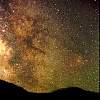 This
was my second guided shot somewhere
near New Idria (4 minute
exposure). This
was my second guided shot somewhere
near New Idria (4 minute
exposure). |
|
|
|
|
| Additional Information |
|---|
| About Astronomy Net | Advertise on Astronomy Net | Contact & Comments | Privacy Policy |
|
Unless otherwise specified, web site content Copyright 1994-2025 John Huggins All Rights Reserved "dbHTML," "AstroGuide," "ASTRONOMY.NET" & "VA.NET" are trademarks of John Huggins |